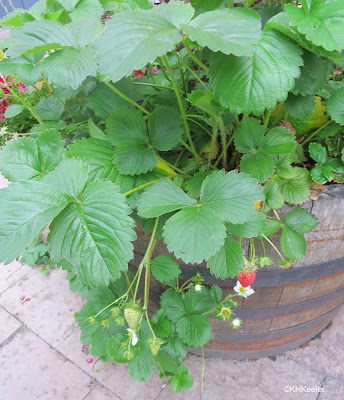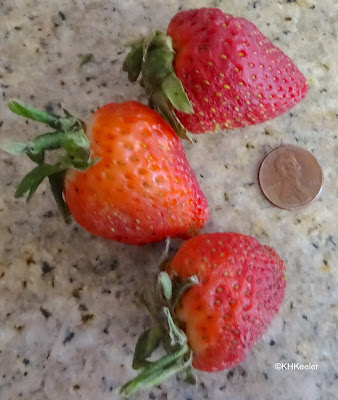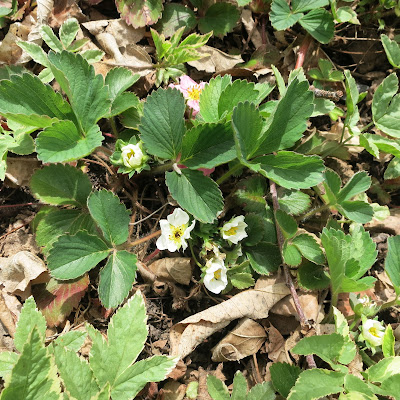Strawberries are popular fruits, eaten world-wide. This is despite the fact that fresh strawberries do not improve after harvest and cannot be stored for very long. So popular are they that we have bred them to produce fruit throughout the growing season, not just briefly in June or July, and ship them from warmer climates or big greenhouses for year-round fresh strawberries, and we freeze them or preserve them as jams and jellies to them always available.
 |
| fruit salad with strawberries |
This is not a new phenomenon. Strawberries are found all across the Northern Hemisphere and down the Andes into South America. Records of eating strawberries go back millennia all around the world. They were grown in gardens in Rome by 200 B.C.E., which is the earliest documented cultivation of strawberries. However the Mapuche, Picunche, and Inca in the South America have been growing strawberries, a different species, for at least 1000 years, breeding red- and white-fruited varieties. The internet says Europeans brought strawberries to China and Japan about 100 years ago, but they mean the modern, cultivated strawberry Fragaria x ananassa. Both China and Japan have native wild strawberries and they mention those a millennium ago or more: in Japan in The Pillow Book of Sei Shonagon written about 950 C.E., and in China in the Pen-ts'ao, from before 500 C.E. It is not clear if the strawberries were cultivated. In North America, Native Americans used strawberries for many things, and colonists in the 1600s and 1700s marveled at the abundance of strawberries in the meadows of the U.S. East Coast. You can argue that both ways easily: abundant wild strawberries can be enjoyed without the work of cultivating them or, strawberries transplant easily, likely people moved them closer to where they lived. In the Pacific Northwest, Native American tribes cultivated camas (Camassia quamash) in the plant's natural habitat, so a garden in the village isn't required for domesticating plants. Regardless of the details, people all around the world knew and ate and used strawberries for millennia.
 |
| strawberries planted in pot |
The 24 species of wild strawberries vary a lot in breeding system. Some are dioecious having female plants that produce fruit but no pollen and male plants that produce pollen but no fruit. Other species have perfect flowers, carrying out both functions in the same flower (also called hermaphrodites). Still other species are intermediate between dioecious and hermaphrodite, for example having some plants in a population that are only female and other plants with perfect flowers. The breeding complexity retarded early European strawberry growers. For example, they weeded out the male plants because they did not produce fruit, which led to poor fruit production by female plants for lack of pollen. Eventually gardeners figured it out, thanks to the insights of Frenchman Antoine Nicolas Duchesne (1747-1827). Fragaria x ananassa started out with male plants, female plants. and some hermaphrodites, but has been bred to be only hermaphrodite, another reason why it is preferred as a cultivated strawberry.
 |
| cultivated strawberries Fragaria x ananassa |
The earliest documented uses of strawberries are as medicine. This makes it sound like our ancestors didn't eat strawberries. That is highly unlikely. Strawberries were certainly a medicine, but medical books were the first books printed in western Europe, after the Bible, because health is so important to everyone. Cookbooks came later. So our records begin with medical uses.
Strawberry fruits are high in vitamins, antioxidants, and fiber. From the Middle Ages they have been recommended as healthy foods for everyone including the old, the very young, and the infirm. They cooled the liver and the blood and quenched thirst. Eating strawberries was believed to ensure a long life.
Strawberries were used to treat gout. The founder of our scientific classification system, Carl von Linné, called Linnaeus, successfully treated his gout attacks by eating strawberries, and only strawberries, and as many as he could hold. As a leading scientist, his story circulated widely. Gout is an excess uric acid and high-vitamin C foods, including strawberries, will lower uric acid levels.
Preparations from strawberry leaves and roots were used to control diarrhea. They also treated headaches, throat infections, and fevers. Drink a potion of them for jaundice. Wash foul ulcers with juice from strawberry leaves to cleanse and cure them. Take it into the mouth to heal a sore mouth, strengthen loose teeth, and heal gums. The list goes on and on. Today, though most of the traditional uses have not been studied for efficacy, the chemicals in strawberry leaves include compounds that have positive dietary polyphenol effects such as slowing cancer and reducing inflamation, and others that are effective antioxidants and antibiotics.
Native American uses of native American strawberries were very similar to the traditional European uses described above. See Moerman, Native American Ethnobotany online database.
Europeans used fresh strawberry fruits as cosmetics. A cut fresh strawberry (several, really) was rubbed on the face to whiten the skin and to treat sunburn. Fresh fruit lightened discolored teeth, when the juice was left on for about five minutes and then the teeth rinsed with warm water to which a bit of bicarbonate of soda (baking soda) was added. Madame Tallien, lady-in-waiting to Queen Marie Antoinette, bathed regularly in a strawberry-raspberry mix that required 22 pints of crushed strawberries. Strawberries were an essential part of a gentlewoman's toilet.
However, red, tasty strawberries are very sensual, so there are many erotic allusions using strawberries throughout Medieval history, and since. For a Medieval example, see the strawberries in the painting (tryptish actually) The Garden of Earthly Delights painted by Hieronymous Bosch (1455-1516) between 1490 and 1510. (see picture in Wikipedia article link).
To dream of strawberries was fortunate. For a man, it predicted a docile wife and many children
"Doubtless God could have made a better berry [than the strawberry], but doubtless God never did;" said Samuel Butler (1612-1680).
Do you agree?
Comments and corrections welcome.
See previous blog for more on the botany of strawberries. link
References
Baker, M. 1978. Gardener's Magic and Folklore. Universe Books, New York.
Bauman, H. and K. Bates, 2015. Food as Medicine. Strawberries (Fragaria x ananassa, Rosaceae). HerbalEGram. #5 May.
Butler, S. quote appears is in Izaak Walton (1593-1683)'s The Compleat Angler, 3rd edition 1661, using the spelling Boteler for Butler.
Charmentier, I. 2014. Linnaeus’s love of strawberries. The Linnean Society of London. link (Accessed 4/5/24).
Culpeper, N. Culpeper's Complete Herbal. W. Foulsham and Company. London. online (Accessed 4/5/24).
Cunningham, S. 1993. Cunningham's Encyclopedia of Magical Herbs. Llewellyn Publications. St. Paul, Minnesota.
Denker, J. S. 2015. The Carrot Purple. Rowman and Littlefield. New York, New York.
Finn, C. E., J. B. Retamales, G. A. Lobos, and J. F. Hancock. 2013.The Chilean Strawberry (Fragaria choloensis): Over a 1000 years of domestication. HortScoemce/ 48 (4): 418-421.
G., F. 1899. Strawberry cure for gout. Nature. 60: 125. https://doi.org/10.1038/060125a0. (Accessed 4/5/24).
Itoh, M. 2016. A brief but sweet history of strawberries in Japan. The Japan Times. link (Accessed 4/5/24).
Jones, J. and B. Deer. 1989. The Country Diary of Garden Lore. Summit Books, New York.
Jones, J. K. 1995. Strawberry Fragaria ananassa (Rosaceae) pp. 412-418 In: J. Smartt and N. W. Simmonds. Evolution of Crop Plants. 2nd ed. Longman Scientific and Technical. Essex, England.
Liston, A., R. Cronin, and T.-L. Ashman. 2014. Fragaria: A genus with deep historical roots and ripe for evolutionary and ecological insightss. American Journal of Botany 101: 1686-1699. link (Accessed 4/4/24)
Nozedar, A. 2010. The Illustrated Signs & Symbols Sourcebook. Metro Books, New York.
Read more about strawberries:
Lewis J.L. 2009. Strawberry Season. Stefan's Florilegium. link (Accessed 4/4/24)
The Gardens Trust. 2017. Saints, Sinners, Sex, and Strawberries. thegardentrust.blog link (Accessed 4/3/24)
Kathy Keeler
A Wandering Botanist
More at awanderingbotanist.com
Join me on Facebook: https://www.facebook.com/AWanderingBotanist



No comments:
Post a Comment